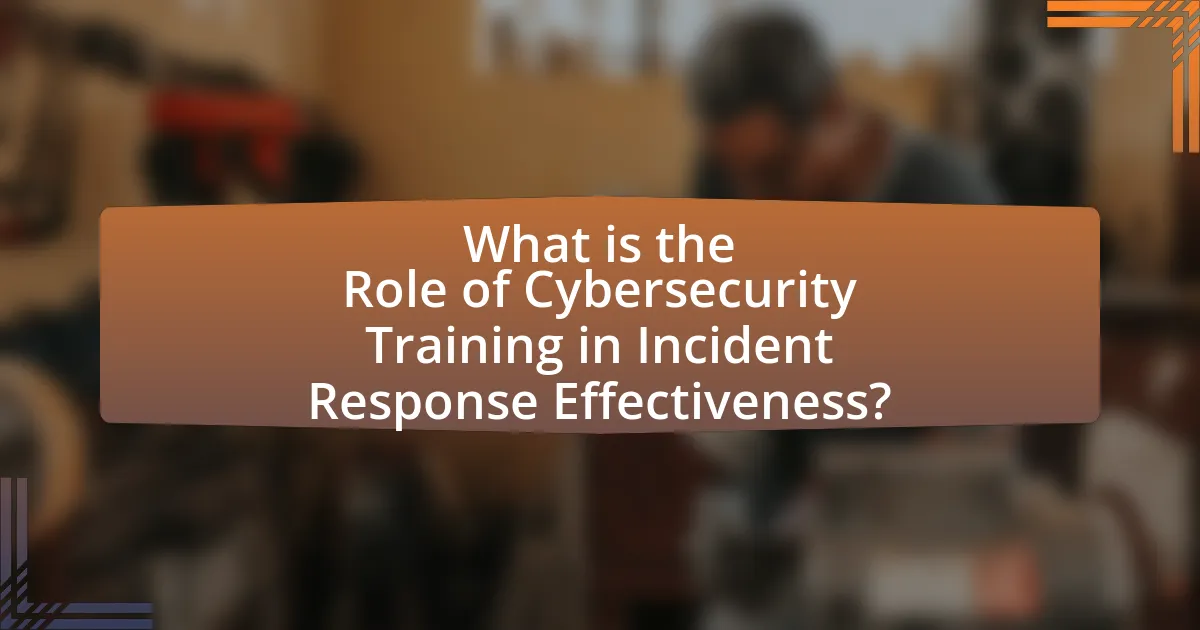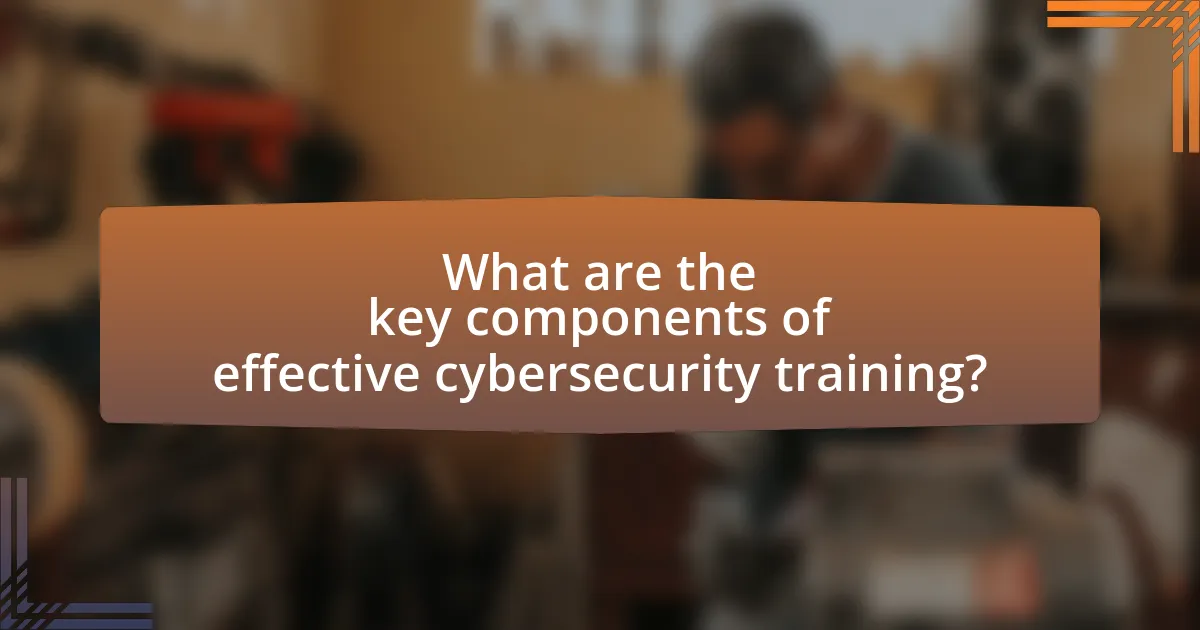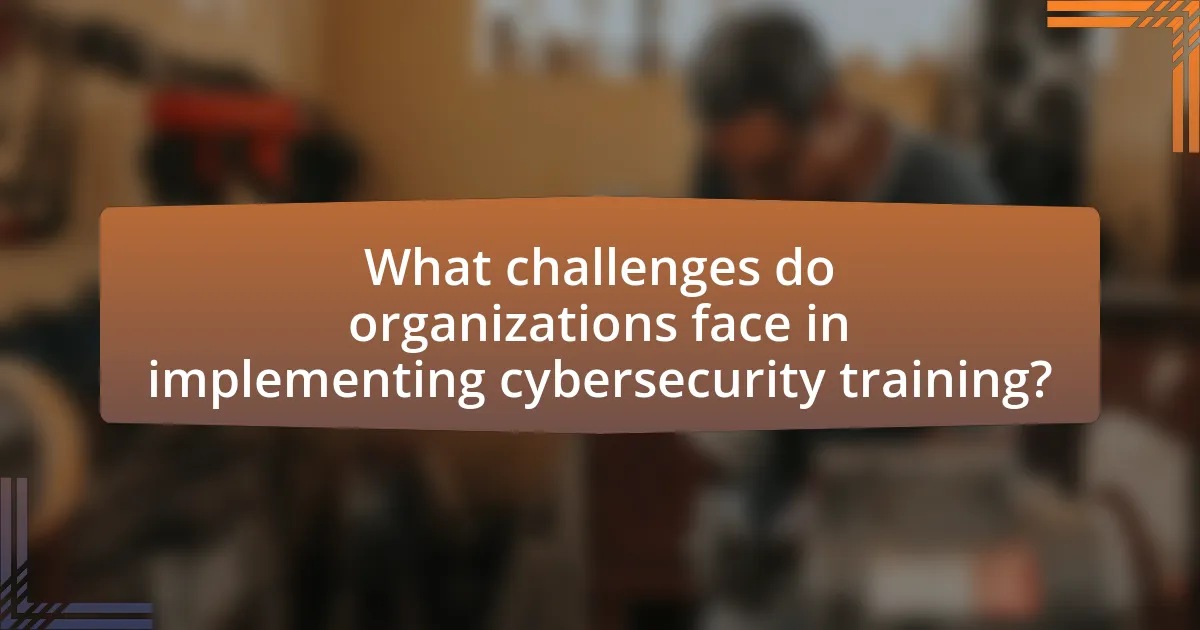The article focuses on the critical role of cybersecurity training in enhancing incident response effectiveness within organizations. It highlights how comprehensive training equips personnel with essential skills to identify, respond to, and mitigate cyber threats, leading to quicker detection and reduced response times. Key components of effective training, such as practical exercises and continuous education, are discussed, along with the impact of training on decision-making and overall security posture. The article also addresses challenges organizations face in implementing training and offers best practices for creating a comprehensive training plan to improve incident response capabilities.

What is the Role of Cybersecurity Training in Incident Response Effectiveness?
Cybersecurity training plays a crucial role in enhancing incident response effectiveness by equipping personnel with the knowledge and skills necessary to identify, respond to, and mitigate cyber threats. Trained employees are more adept at recognizing potential security incidents, which leads to quicker detection and reporting. For instance, a study by the Ponemon Institute found that organizations with comprehensive security awareness training experienced a 70% reduction in the average time to detect a data breach. This training also fosters a culture of security within the organization, encouraging proactive behavior and adherence to best practices. Consequently, effective cybersecurity training directly correlates with improved incident response times and overall organizational resilience against cyber threats.
How does cybersecurity training impact incident response teams?
Cybersecurity training significantly enhances the effectiveness of incident response teams by equipping them with the necessary skills and knowledge to identify, analyze, and mitigate security threats. Trained teams demonstrate improved response times and decision-making capabilities during incidents, as they are familiar with protocols and best practices. For instance, a study by the Ponemon Institute found that organizations with comprehensive cybersecurity training programs experienced a 50% reduction in the average time to detect and respond to breaches compared to those without such training. This evidence underscores the critical role that training plays in preparing incident response teams to handle cyber threats efficiently and effectively.
What skills are developed through cybersecurity training?
Cybersecurity training develops critical skills such as threat analysis, incident response, risk management, and security policy implementation. These skills enable individuals to identify vulnerabilities, respond effectively to security incidents, assess risks, and enforce security protocols. Research indicates that organizations with trained personnel experience a 50% reduction in security breaches, highlighting the effectiveness of such training in enhancing incident response capabilities.
How does training improve decision-making during incidents?
Training enhances decision-making during incidents by equipping individuals with the necessary skills and knowledge to respond effectively. This preparation allows personnel to recognize threats quickly, assess situations accurately, and implement appropriate responses based on established protocols. Research indicates that organizations with regular training programs experience a 50% reduction in response time during cybersecurity incidents, demonstrating the direct impact of training on operational efficiency. Furthermore, trained individuals are more likely to follow best practices and utilize critical thinking, leading to improved outcomes in high-pressure scenarios.
Why is cybersecurity training essential for incident response?
Cybersecurity training is essential for incident response because it equips personnel with the necessary skills and knowledge to effectively identify, manage, and mitigate security incidents. Trained employees are more adept at recognizing potential threats and understanding the protocols for responding to them, which significantly reduces response times and minimizes damage. According to a report by the Ponemon Institute, organizations with comprehensive security awareness training programs experience 70% fewer security incidents. This statistic underscores the critical role that training plays in enhancing an organization’s overall cybersecurity posture and incident response capabilities.
What are the consequences of inadequate training in incident response?
Inadequate training in incident response leads to increased vulnerability to cyber threats and ineffective handling of security incidents. Organizations lacking proper training may experience delayed response times, resulting in greater damage during a security breach. For instance, a study by the Ponemon Institute found that organizations with well-trained incident response teams can reduce the cost of a data breach by an average of $1.23 million compared to those without such training. Additionally, inadequate training can result in miscommunication among team members, leading to inconsistent actions during an incident, which further exacerbates the situation. Ultimately, the lack of effective training compromises an organization’s ability to protect sensitive data and maintain operational integrity.
How does training influence the overall security posture of an organization?
Training significantly enhances the overall security posture of an organization by equipping employees with the knowledge and skills necessary to recognize and respond to cybersecurity threats. When employees undergo regular training, they become more adept at identifying phishing attempts, understanding security protocols, and adhering to best practices, which collectively reduce the likelihood of successful cyberattacks. For instance, a study by the Ponemon Institute found that organizations with comprehensive security awareness training programs experienced 70% fewer successful phishing attacks compared to those without such training. This evidence underscores the critical role that training plays in fortifying an organization’s defenses against cyber threats.

What are the key components of effective cybersecurity training?
The key components of effective cybersecurity training include awareness, practical exercises, policy understanding, and continuous education. Awareness training educates employees about common threats such as phishing and malware, which is crucial since human error accounts for approximately 90% of data breaches. Practical exercises, such as simulated attacks, help reinforce learning and prepare employees for real-world scenarios. Understanding organizational policies ensures that employees know the protocols for reporting incidents and responding to threats. Continuous education is essential to keep staff updated on evolving threats and technologies, as the cybersecurity landscape is constantly changing.
What types of training programs are available for incident response?
Various types of training programs are available for incident response, including tabletop exercises, simulation-based training, and formal certification courses. Tabletop exercises involve scenario-based discussions that help teams practice their response strategies in a controlled environment. Simulation-based training provides hands-on experience by mimicking real-world incidents, allowing participants to apply their skills in a practical setting. Formal certification courses, such as those offered by organizations like (ISC)² and CompTIA, provide structured learning paths that cover essential incident response concepts and best practices. These training programs are designed to enhance the effectiveness of cybersecurity teams in managing and mitigating incidents.
How do hands-on simulations enhance learning outcomes?
Hands-on simulations enhance learning outcomes by providing experiential learning opportunities that engage participants in realistic scenarios. This active participation allows learners to apply theoretical knowledge in practical situations, which has been shown to improve retention and understanding. Research indicates that simulations can increase knowledge retention by up to 75% compared to traditional learning methods, as learners are more likely to remember information they have actively engaged with. Additionally, simulations foster critical thinking and problem-solving skills, essential for effective incident response in cybersecurity, as they require participants to make decisions under pressure and adapt to evolving situations.
What role do certifications play in cybersecurity training?
Certifications play a crucial role in cybersecurity training by validating the knowledge and skills of professionals in the field. They provide a standardized measure of competency, ensuring that individuals possess the necessary expertise to address cybersecurity challenges effectively. For instance, certifications such as Certified Information Systems Security Professional (CISSP) and Certified Ethical Hacker (CEH) are recognized globally and demonstrate a commitment to maintaining industry standards. Research indicates that organizations with certified cybersecurity personnel experience fewer security breaches, highlighting the effectiveness of training programs that incorporate certifications.
How can organizations assess the effectiveness of their training programs?
Organizations can assess the effectiveness of their training programs by measuring key performance indicators (KPIs) such as knowledge retention, behavior change, and incident response times. For instance, pre- and post-training assessments can quantify knowledge retention, while simulations and real-world incident responses can evaluate behavior change and practical application of skills. A study by the Ponemon Institute found that organizations with effective cybersecurity training programs experienced a 50% reduction in incident response times, demonstrating the direct impact of training on performance.
What metrics should be used to evaluate training success?
To evaluate training success in cybersecurity, key metrics include knowledge retention, incident response time, and the number of incidents successfully mitigated. Knowledge retention can be assessed through pre- and post-training assessments, which typically show an increase in understanding of cybersecurity protocols. Incident response time is measured by the duration taken to identify and respond to simulated attacks, with effective training leading to a reduction in this time. Additionally, tracking the number of incidents that are successfully mitigated post-training provides a clear indicator of the training’s impact on real-world performance. These metrics collectively demonstrate the effectiveness of cybersecurity training in enhancing incident response capabilities.
How can feedback from incident response exercises inform training improvements?
Feedback from incident response exercises can inform training improvements by identifying gaps in knowledge and skills among participants. This feedback allows organizations to tailor their training programs to address specific weaknesses, ensuring that team members are better prepared for real incidents. For instance, after conducting a tabletop exercise, a cybersecurity team may discover that members struggle with communication protocols during a crisis. This insight can lead to targeted training sessions focused on enhancing communication skills and understanding of protocols. Additionally, analyzing performance metrics from these exercises can highlight areas where response times lag, prompting the development of more effective training modules aimed at improving efficiency.

What challenges do organizations face in implementing cybersecurity training?
Organizations face several challenges in implementing cybersecurity training, including employee engagement, resource allocation, and the rapidly evolving threat landscape. Employee engagement is critical, as many staff members may view training as a burden rather than a necessity, leading to low participation rates. Resource allocation poses another challenge, as organizations often struggle to dedicate sufficient time and budget to comprehensive training programs. Additionally, the rapidly evolving nature of cyber threats requires continuous updates to training content, making it difficult for organizations to keep their training relevant and effective. According to a report by the Ponemon Institute, 60% of organizations cite lack of employee engagement as a significant barrier to effective cybersecurity training, highlighting the importance of addressing these challenges for improved incident response effectiveness.
What are common barriers to effective training in incident response?
Common barriers to effective training in incident response include lack of resources, insufficient time, and inadequate training materials. Organizations often struggle with limited budgets, which restricts access to quality training programs and tools. Additionally, employees frequently face time constraints due to their regular job responsibilities, making it challenging to prioritize incident response training. Furthermore, many training materials may not be up-to-date or relevant to current threats, leading to gaps in knowledge and preparedness. These factors collectively hinder the ability of organizations to effectively train their personnel in incident response.
How can organizations overcome budget constraints for training?
Organizations can overcome budget constraints for training by leveraging cost-effective methods such as online training platforms, partnerships with educational institutions, and utilizing in-house expertise for training sessions. Online platforms like Coursera and Udemy offer affordable courses that can be scaled across the organization, significantly reducing costs compared to traditional training methods. Collaborating with universities can provide access to resources and expertise at a lower cost, while in-house training utilizes existing staff to share knowledge, minimizing external expenses. According to a report by the Association for Talent Development, organizations that invest in employee training see a 24% higher profit margin, demonstrating that strategic training investments can yield significant returns even within budget limitations.
What strategies can be employed to ensure employee engagement in training?
To ensure employee engagement in training, organizations can implement interactive training methods, such as simulations and gamification. These strategies actively involve employees in the learning process, making the training more relevant and enjoyable. Research indicates that interactive training can increase retention rates by up to 75%, compared to traditional lecture-based methods, which typically yield retention rates of only 5-10%. Additionally, providing opportunities for feedback and incorporating real-world scenarios related to cybersecurity can enhance engagement by making the training applicable to employees’ daily tasks.
How does organizational culture affect cybersecurity training outcomes?
Organizational culture significantly influences cybersecurity training outcomes by shaping employee attitudes, behaviors, and engagement levels towards security practices. A positive culture that prioritizes security fosters a proactive approach among employees, leading to higher retention of training material and better application of security protocols. For instance, organizations with a strong emphasis on continuous learning and open communication typically report a 30% increase in employee participation in cybersecurity training programs, as noted in a study by the Ponemon Institute. Conversely, a negative culture characterized by fear or blame can result in lower participation and a lack of accountability, ultimately diminishing the effectiveness of training initiatives.
What practices can foster a culture of continuous learning in cybersecurity?
Implementing regular training sessions and workshops fosters a culture of continuous learning in cybersecurity. These practices ensure that cybersecurity professionals stay updated on the latest threats, tools, and techniques. For instance, organizations that conduct monthly training sessions report a 30% increase in incident response effectiveness, as employees are better equipped to handle emerging threats. Additionally, creating a mentorship program encourages knowledge sharing among team members, further enhancing collective expertise. Research shows that organizations with structured learning initiatives experience a 50% reduction in security breaches, highlighting the importance of continuous education in maintaining robust cybersecurity defenses.
How can leadership support effective training initiatives?
Leadership can support effective training initiatives by allocating resources, setting clear objectives, and fostering a culture of continuous learning. By providing financial support and time for training, leadership ensures that employees have access to necessary tools and programs. Establishing specific, measurable goals for training outcomes aligns the training with organizational objectives, enhancing its relevance and effectiveness. Furthermore, promoting an environment that values ongoing education encourages employees to engage actively in training, which is crucial for improving incident response effectiveness in cybersecurity. Research indicates that organizations with strong leadership support for training see a 30% increase in employee performance and retention, highlighting the importance of leadership in driving successful training initiatives.
What best practices should organizations follow for cybersecurity training?
Organizations should implement continuous and interactive cybersecurity training programs to enhance employee awareness and response capabilities. Regular training sessions, ideally conducted quarterly, ensure that employees stay updated on the latest threats and best practices. Interactive elements, such as simulations and hands-on exercises, engage participants and reinforce learning, making them more likely to retain information.
Additionally, organizations should tailor training content to specific roles within the company, as different departments face unique cybersecurity challenges. For instance, IT staff may require advanced training on network security, while general employees should focus on recognizing phishing attempts.
Furthermore, organizations should assess training effectiveness through regular evaluations and feedback mechanisms. According to a study by the Ponemon Institute, organizations that conduct frequent training and assessments experience a 50% reduction in the likelihood of a data breach. This statistic underscores the importance of ongoing education in fostering a culture of cybersecurity awareness and preparedness.
How can organizations create a comprehensive training plan?
Organizations can create a comprehensive training plan by conducting a thorough needs assessment to identify specific skills and knowledge gaps related to cybersecurity. This assessment should involve analyzing past incidents, understanding regulatory requirements, and gathering input from stakeholders to tailor the training content effectively.
Additionally, organizations should establish clear objectives for the training program, ensuring that they align with overall cybersecurity goals and incident response strategies. Incorporating a variety of training methods, such as hands-on simulations, e-learning modules, and workshops, can enhance engagement and retention of information.
Regularly updating the training materials to reflect the latest threats and best practices is essential for maintaining relevance. Furthermore, organizations should implement metrics to evaluate the effectiveness of the training, such as pre- and post-training assessments, to measure knowledge retention and application in real-world scenarios. This structured approach ensures that the training plan is comprehensive and effective in improving incident response capabilities.
What ongoing training methods can keep skills current in incident response?
Ongoing training methods that can keep skills current in incident response include simulation exercises, continuous education programs, and participation in cybersecurity competitions. Simulation exercises, such as tabletop drills and live-fire scenarios, allow incident response teams to practice their skills in realistic environments, enhancing their ability to respond effectively to actual incidents. Continuous education programs, including online courses and certifications, ensure that professionals stay updated on the latest threats and technologies, as the cybersecurity landscape evolves rapidly. Participation in cybersecurity competitions, like Capture the Flag events, fosters practical skills and teamwork, reinforcing knowledge through hands-on experience. These methods are supported by industry standards, such as the National Institute of Standards and Technology (NIST) guidelines, which emphasize the importance of regular training to maintain readiness in incident response.
